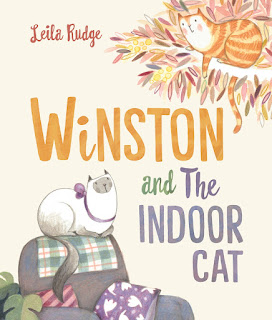Winston is happy with his outdoor life. He has no idea that other cats have an entirely different life indoors. Surely the Indoor Cat needs to be set free. Winston finds a way to open the door and the Indoor Cat does spend some time outside but he decides the indoors are better. He invites Winston inside but the indoors do not really suit him unless perhaps (spoiler alert) it is a rainy day.
This version of Town Mouse and Country Mouse is perfect for a very young child. It is good to see the use of a more complex but still accessible vocabulary with words such as pristine; exhilarated; and leisure. The small twist at the end is again, sure to appeal to a very young child. The end papers could be used as a discussion point about the food given to the indoor cat contrasted with the food found by the outdoor cat.
I wonder why the outdoor cat has a name – Winston - but the indoor cat has no name? The change of colours from orange tones for outdoors and grey and blue tones for indoors works well to define their living spaces.
Winston and the Indoor cat has been short listed for the CBCA Book of the Year award early Childhood. Here are the comments from the judges:
Friendship and individuality are explored in this gently told story of two very different cats. Winston, the outdoor cat, tries to entice the indoor cat outside, while the indoor cat, who is comfortable with its leisurely life, tempts Winston into its world inside the house. Characterisation is developed through subtle expressions of the cats when they find themselves outside their respective normal environments. With short sentences and concise phrases, young children will delight in listening to the words while being captivated by the illustrations. Beautiful, soft watercolour and pencil illustrations vary from full-page spreads to small vignettes and the final sequence where the cats agree to disagree and find common ground is a satisfying and humorous resolution.
I was chatting with my friend from Kinderbookswitheverything about sharing this book with her youngest students. She was surprised to discover only one or two children in each group actually owned a pet cat. The concept of keeping a cat inside and that the cat would be content to stay inside and not feel trapped was a very difficult one for many of these five year-olds.
As a companion book my friend read this one:
You will also want to share a few versions of Town Mouse and Country Mouse alongside Winston and the Indoor cat.
If you are sharing Winston and the Indoor cat with a group of younger children try to find this little beginning chapter book:
I would also look for this one:
With a group of older students you might share this book which compares the domestic Dog with his cousin the Wolf.










No comments:
Post a Comment